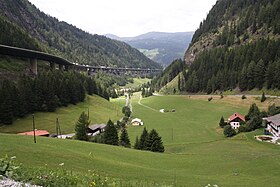Brenner Pass
| Brenner Pass | |
|---|---|
 View between the top of the pass and Gries am Brenner | |
| Elevation | 1,370 m (4,495 ft) |
| Traversed by | E45 motorway |
| Location | |
| Range | Alps |

Brenner Pass (German: Brennerpass; Italian: Passo del Brennero) is a mountain pass through the Alps along the border between Italy and Austria, and is one of the principal passes of the Alps. It is the lowest of the Alpine passes, and one of the few in the area. For that reason possession of the pass has long been coveted.
Below the pass, high Alpine pastures have been used by dairy cattle for summer grazing, making space available at lower altitudes for cultivating and harvesting hay for winter fodder. Many of the high pastures are at altitudes over 1,000 metres.
The central section, the Brenner Pass itself, covers the track between Sterzing and Matrei, through the village of Brenner.
Etymology
Prenner was originally the name of a nearby farm which derived from its former owner. The farm of a certain Prennerius is mentioned in documents in 1288, a certain Chunradus Prenner de Mittenwalde is mentioned in 1299. The name Prenner is traced back to the German word for somebody who clears woodland. A name for the pass itself appears for the first time in 1328 as ob dem Prenner (German for above the Prenner).[1]
History
The Romans regularized the already traditional crossing.[2] The first Roman road connecting Italy with the province of Raetia north of the Alps, Via Claudia Augusta, was finished in 46–47 AD, but it did not cross the Brenner. The road started in Verona and followed the Adige valley to the Reschen Pass from where it descended into the Inn valley and from there over the Fern Pass to Augusta Vindelicorum (Augsburg). Not until the 2nd century AD was a road over the Brenner Pass opened: coming through the Puster Valley, the road crossed the Brenner and descended from there to Veldidena (today Wilten), where it crossed the Inn and then the Zirler Berg towards Partenkirchen and on to Augusta Vindelicorum.
The Alamanni crossed the Brenner Pass southward into Italy in 268 AD, to be stopped in November at the Battle of Lake Benacus.[3] In the High Middle Ages, it was part of the important Via Imperii, an imperial road linking the Kingdom of Germany north of the Alps with the Italian March of Verona, since the 12th century controlled by the Counts of Tyrol. Emperor Frederick Barbarossa usually crossed the Alps through Brenner Pass in his Imperial expeditions into Italy.[4]
The pass however was not more than a trackway for mule trains and carts until a carriage road was laid out in 1777 at the behest of Empress Maria Theresa. The Brenner Railway was completed in 1867 and is the only transalpine rail route without a major tunnel. Since the end of World War I in 1918, when international borders shifted, control of the pass has been shared between Italy and Austria. Until then, both sides of the pass had been within the Habsburg-ruled Austro-Hungarian Empire. During World War II, the German leader Adolf Hitler and the Italian leader Benito Mussolini met there to celebrate their Pact of Steel on 18 March 1940. The pass was a part of the ratlines for some Nazis after the German surrender in 1945.
| Brenner Pass | ||||||||||||||||||||||||||||||||||||||||||||||||||||||||||||
|---|---|---|---|---|---|---|---|---|---|---|---|---|---|---|---|---|---|---|---|---|---|---|---|---|---|---|---|---|---|---|---|---|---|---|---|---|---|---|---|---|---|---|---|---|---|---|---|---|---|---|---|---|---|---|---|---|---|---|---|---|
| Climate chart (explanation) | ||||||||||||||||||||||||||||||||||||||||||||||||||||||||||||
| ||||||||||||||||||||||||||||||||||||||||||||||||||||||||||||
| ||||||||||||||||||||||||||||||||||||||||||||||||||||||||||||
Roadways
The motorway E45 (European designation; in Italy A 22, in Austria A 13) leading from Innsbruck via Bolzano to Verona and Modena uses this pass, and is one of the most important north-south connections in Europe. Even with the removal of customs, the long traffic jams before the Brenner Pass are dreaded by Northern Europeans who want to spend their holidays on the Mediterranean coast.
The Europabrücke (Europe Bridge), located just outside of Innsbruck and a few km north of the Brenner Pass, is a large concrete bridge carrying the six-lane autobahn over the valley of the Sill River. At a height of 180 metres and a length of 820 metres, it was celebrated as a masterpiece of engineering upon its completion in 1963.
The heavy freight traffic travelling through the Inn Valley to reach the Brenner Pass, polluting this scenic area, causes much debate in regional and European politics. About 1.8 million trucks crossed the Europa Bridge in 2004.[5]
In order to ease the road traffic, there are plans to upgrade the railroad from Verona to Innsbruck with a series of tunnels, including the Brenner Base Tunnel under the Brenner Pass.[6] While the official groundbreaking of the tunnel took place in 2006 (with survey tunnels drilled in the same year), substantial work was not slated to begin until 2011, and the tunnel's planned date of completion is in 2025.[7]
In popular culture
The Brenner Pass appears in the video game Tom Clancy's EndWar as a potential battlefield.[8]
See also
References
- ^ Egon Kühebacher (1991), Die Ortsnamen Südtirols und ihre Geschichte, Bozen: Athesia, p. 59
- ^ Walter Woodburn Hyde, Roman Alpine Routes (Philadelphia: University of Pennsylvania Press) 1935:194, "the use of the major pass-routes has been continuous from prehistoric times down to the present".
- ^ "Geschichte Schwabens bis zum Ausgang des 18. Jahrhunderts" by Max Spindler, Christoph Bauer, Andreas Kraus, 3rd edition; publisher: C.H.Beck Verlag 2001 page 80 ISBN 3-406-39452-3, ISBN 978-3-406-39452-2
- ^ Santosuosso, Antonio (2004). Barbarians, Marauders, and Infidels: The Ways of Medieval Warfare. New York, NY: MJF Books. p. 190. ISBN 978-1-56731-891-3.
- ^ http://www.swissinfo.org/sen/Swissinfo.html?siteSect=111&sid=5428539
- ^ Galleria di Base del Brennero – Brenner Basistunnel BBT SE – Offline
- ^ http://tirv1.orf.at/stories/496375
- ^ Ubisoft (2008). "Locations". Ubisoft. Retrieved 1 April 2011.
External links
Chisholm, Hugh, ed. (1911). . Encyclopædia Britannica (11th ed.). Cambridge University Press.

